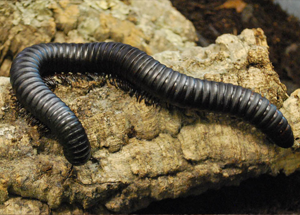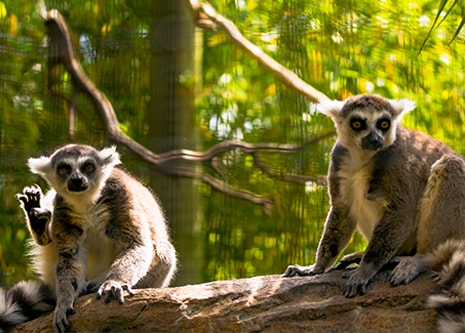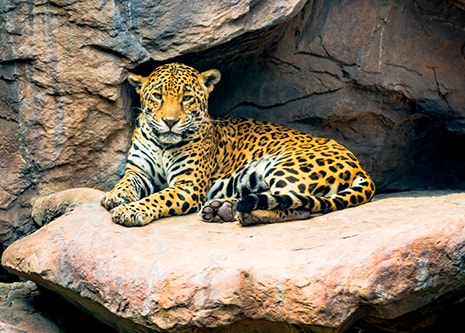
- VisitSupport Happy HollowDONATE TODAYExploreSupport Happy HollowDONATE TODAYLearnSupport Happy HollowDONATE TODAYSupportToday’s Hours: CLOSEDEducation Ambassadors
Giant African millipede

Scientific name: Archispirostreptus gigas
Family: Spirostreptidae
Order: Spirostreptida
Class: Diplopoda
Range: Eastern Africa
Habitat: Subtropical and Tropical Forest
Lifespan: 7 to 10 yearsWhat do they look like?
Giant African millipedes are some of the world’s largest millipedes, on average reaching 8-12 inches in length, and sometimes reaching up to 15 inches! The word “millipede” translates to “thousand foot.” While they do look like they have a lot of feet, millipedes only have four legs per body segment, which for this species results in 100-400 legs as adults. They have two antennae, two simple eyes, and a dark brown or black exoskeleton (outer skeleton that protects the animal).How do they behave?
Giant African millipedes are nocturnal (most active at night). They have poor eyesight and rely heavily on their antenna to navigate, which they use for smelling and feeling. They move slowly with their legs making a wavelike motion because they cannot move their legs individually. This species is terrestrial (living on or burrowing into the ground). They spend much of their time buried under leaf litter or in loose soil. If threatened, they roll into a tight coil, and if further pestered they will excrete a toxic chemical with a foul smell and taste to deter predators.What do they eat?
Millipedes are detritivores (have a diet consisting of decomposing plant matter), and will eat leaves, fruits, and other vegetation on the forest floor. The excrement they produce is rich in nutrients that replenish the soil they live in. At Happy Hollow they are fed fruits, vegetables and vitamin supplements.How are they born?
Mature millipedes attract mates by producing pheromones (chemical signals). Males can be distinguished from females by a pair of gonopods (appendages that allow for fertilization) on the seventh body segment. Females lay hundreds of eggs in hollow nests under the surface of the soil. Eggs are protected by a tough outer layer, often composed of fecal material from the mother, and will hatch a few weeks later. There is no additional care from the parents. Neonates (just hatched millipedes) are white and only have three body segments. As they grow they will periodically molt (replace their smaller exoskeleton with a newer, larger one) until they reach their adult size, each time adding segments and legs as they mature.Conservation
Giant African millipedes have not been evaluated by the International Union for Conservation of Nature . Their secretive nature makes it difficult for scientists to obtain data about them. There are approximately 7,000 species of millipede in the world, and each one serves an important purpose as a decomposer in its environment. The Xerces Society for Invertebrate Conservation is one organization that is actively working with scientists and conservationists to further research, raise awareness and work toward protecting and managing invertebrate species such as the millipede. For more information on how to support invertebrate conservation, you can visit http://www.xerces.org. If you would like to assist local millipede species, you can turn to native plants for landscaping, all-natural household cleaners, and reducing outdoor chemical usage to prevent groundwater contamination and keep local millipedes healthy! Leaving fallen leaves on the ground will also provide them with food and shelter.
Zoo on the Hill
Located across from the Keep-Around Carousel is the Zoo on the Hill. Learn about wildlife up close during daily meet-and-greets, leap like a lemur on the playground, brush and feed the goats,, or take a peek inside Doc’s Critter Care building and the Ranch House. Double-H Ranch features a combination of animal exhibits, including giant anteaters and red ruffed lemurs, as well chickens and domesticated animals that are docile enough to touch.
See Animals
Zoo in the Hollow
Follow the crooked bamboo pathway down into the hollow and visit with some of the most amazing animals in the world. Where else in San José can you get up close to a stunning jaguar, lemur, meerkat or American alligator? Happy Hollow is dedicated to helping save species and preserve wildlife for future generations by participating in Species Survival Plan programs through the Association of Zoos and Aquariums.
See AnimalsVisit Us Today
Plan an unforgettable experience at San Jose’s family-friendly park and zoo.
more info